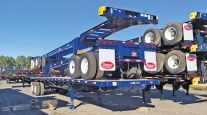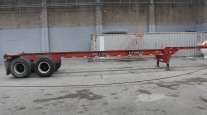Drive to Make Freight Shipments More Efficient Places New Spotlight on Chassis Management
This story appears in the June 7 print edition of Transport Topics.
A generation ago, railroad clerks used four words — “your pig is here” — to inform truckers that an intermodal trailer shipment had arrived and was ready for pickup.
Today, that industry slang word for “piggyback” trailers is gone, a victim of change as nine in 10 intermodal shipments now move in more cost-effective containers. In addition, the clerk has become another victim of cost-cutting, supplanted by electronic arrival notifications.
But as drayage carriers approach the summer of 2010, another round of changes is washing over the intermodal industry: New federal chassis safety standards remain unresolved, chassis ownership may be dropped into their collective laps and business levels are just starting to come back.
“The intermodal industry has been in transition for the last 30 years,” Daniel Smith, a principal at intermodal consultant Tioga Group Inc., Moraga, Calif., told Transport Topics. “The transition isn’t going to stop anytime soon.”
The most immediate challenge is the decadelong effort to overhaul federal chassis safety rules to lift the liability burden from truckers and make ocean carriers responsible for chassis condition. Those rules take effect on June 30 without an agreement on how to handle a critical process — the inspection reports meant to ensure that chassis are safe, or “roadable.”
“We in the intermodal industry are still trying to figure out how to set up this inspection process for equipment reports,” said Curtis Whalen, executive director of the Intermodal Motor Carrier Conference. Those talks involve ocean carriers and railroads, as well as truckers.
Keeping track of equipment condition through those reports is a key to effective implementation of the roadability rules because truckers use chassis to make 20 million trips a year delivering container shipments, and a driver vehicle inspection report, or DVIR, currently is required for every truck trip.
Meanwhile, the Federal Motor Carrier Safety Administration is weighing a petition from the ocean carriers and lessors. Those groups believe DVIRs aren’t needed unless there is a defect, which they say occurs only about 4% of the time.
FMCSA declined to comment to TT about the petitions.
The lack of agreement on handling those reports is the last hurdle to overcome before the once-delayed roadability program takes effect, one industry leader said.
“I could not in good faith tell you the industry is ready for this change on June 30, though lots of well-intended people are trying hard,” said Greg Stefflre, CEO of drayage carrier Rail Delivery Services, Fontana, Calif., and a former chairman of Whalen’s group.
“Ultimately, I want handhelds to handle this [report filing], and I can’t do that until I know what the rules are,” he said.
Two other drayage carriers agreed.
“The regulations are still unclear to us,” Jeffrey Bader, president of Golden Carriers, Hillside, N.J., told TT. “There is still a lack of knowledge in the industry, especially on the DVIR.”
Philip Byrd, president of Bulldog Hiway Express, North Charleston, S.C., said keeping track of equipment condition is crucial to smooth introduction of roadability.
“I can have a driver bring in the equipment with no defects to an ocean terminal,” he said. “Then it can be used in the terminal for weeks, and there can be a completely different state of repair when it’s ready to go back out on the road.”
Smith said the debate over roadability is “definitely an issue” in another intermodal transition: whether the ocean carrier or the trucker provides those chassis in the future.
“I don’t know if roadability pushed them over the edge, though,” he said.
Ocean carriers are weighing an exit from the chassis business in the United States, the last place where they provide chassis to truckers.
Last year, biggest carrier Maersk Line began charging drayage carriers to use its equipment instead of providing it for free, as most competitors still do. The company reported its first loss since World War II in 2009.
“The truth is, it’s not about the money, it’s about changing the industry to the global best practices in order to achieve environmental and operational efficiencies that will benefit everyone in the supply chain,” Maersk spokeswoman Mary Ann Kotlarich explained when the program was announced. She also said the move was meant to encourage more efficient use of chassis maintained to its quality standards.
Bader and others protested the switch at the time, saying it raised costs. Now, however, he admits that carriers in the New York/New Jersey area have adjusted to the change.
That’s a good thing, because two other ocean carriers recently began to abandon chassis, and others signaled they could follow suit and transfer that responsibility to truckers.
Ocean carriers control 85% of chassis in the United States, while truckers have 5%, with railroads owning the rest.
“This is an overdue change that is coming at a very awkward time,” Smith said, because of the recession. “The truckers are getting an added cost pushed on them. Truckers will have to figure how to provide the chassis with no additional revenue.”
Cost burdens will fall harder, he said, on “mom and pop” companies that don’t have the resources to buy or rent chassis, Smith said.
However, even Atlanta-based RoadLink, the largest drayage carrier, has no interest in owning chassis, at least right now.
“Chassis ownership is a big step,” said John Anderson, chairman of RoadLink, whose 2009 revenue topped the drayage industry at $439 million and is No. 59 on the Transport Topics 100 list of the largest for-hire carriers in the United States and Canada.
“We couldn’t go into the chassis business in the current economy,” Anderson said. “We don’t have the pricing and collection mechanisms for us to say we will control and own chassis.”
Stefflre cited another reason to steer clear of chassis. There is no practical way to control who else might wind up using them as drivers move from assignment to assignment and have to leave the chassis with a container on it at a customer’s dock, carrier terminal or warehouse, he said.
“In those situations, if the trucker owns the chassis, what does he do?” Stefflre said. “I don’t want to lose control of that chassis.”
Others prefer to own chassis, believing that asset has other commercial selling points.
“We have been a strong advocate of chassis for a long time,” said Byrd, whose company provides both intermodal and truckload services. “We have an asset that we can control and we maintain in good condition. It also gives us pricing leverage.”
He estimated that company chassis are used for about 25% of Bulldog’s intermodal business.
Bader said his company handles the chassis-ownership issue by providing that equipment to its owner-operators.
Whalen, whose group is part of American Trucking Associations, said chassis ownership “is causing a lot of angst among motor carriers,” and he highlighted chassis pools that truckers can use to haul any ocean carrier’s box.
“That’s the intermediate step for ocean carriers to distance themselves from chassis,” Whalen added.
As the transition to eventual trucker control continues, Smith expects many approaches will emerge.
“There will be a mixed system permanently,” Smith said. “One solution won’t be right for all truckers. If a carrier needs a short-term solution, they can a use pool. If I have long-term need, then I lease. If I have access to capital, and interest rates are low, that is a good time to buy.”
The chassis transition has still another dimension.
“The issues of chassis ownership, pools and roadability have a direct link to the economy,” Whalen said, noting that lower international cargo during the recession helped to avoid freight flow snafus as new federal port security rules took effect.
Whalen believes there is a possibility that disruptions could resurface as intermodal cargo surges again. That freight rose 8.4% in the first quarter, according to the Intermodal Association of North America.
“It’s going to be a strain on the intermodal system to bring in roadability now that times are better,” he said.




